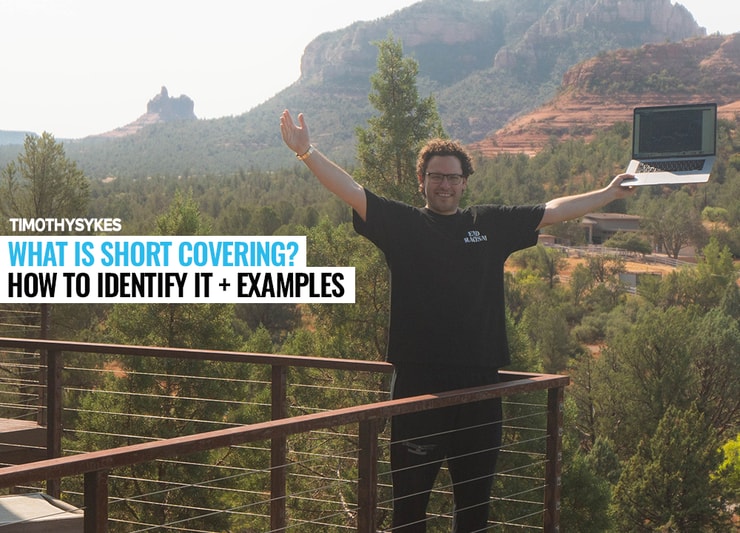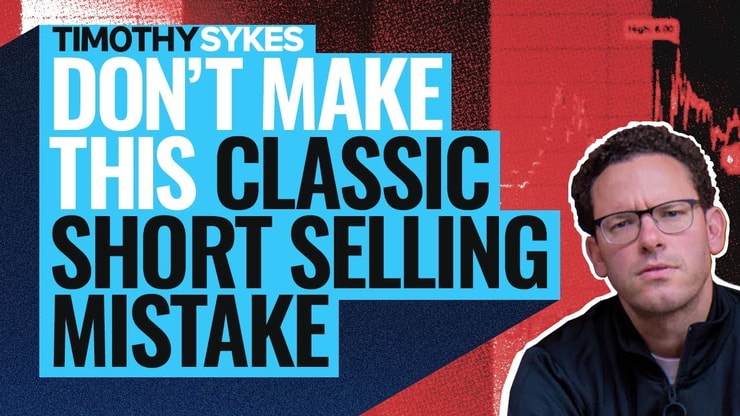Short covering may be one of the more neglected aspects of shorting — the exit strategy.
For newbies, short selling carries more danger than going long on a stock. When you go short, you can lose more than you’ve put in. This is a good way to blow your account up, fast.
Maybe you’re seeing short sellers on Twitter boasting about their latest wins. (They’re quieter about their losses, borrow fees, and account sizes.) You see traders cleaning up in this rollercoaster of a market, and you want in.
You’re excited, and that’s a good thing. But before you try strategies you’re not fully comfortable with, I want you to put that energy into studying.
Build your knowledge account before you try to build your trading account.
I have a ton of free resources on the ins and outs of short selling. I’ve also got a fair bit on the risks.
When you get really committed to this life, I want you in my Trading Challenge. It’s the kind of community that I wish I had when I was starting out. We share strategies, trading plans, and much more. This stuff is super important when you’re margin account. Specifically for short selling.
Your exit strategy is the most important part of your trading plan. So let’s break it down.
Table of Contents
- 1 What Is Short Covering?
- 2 How Does Short Covering Work?
- 3 So, Is Short Covering Good or Bad?
- 4 Short Covering and Short Squeeze: What’s the Difference?
- 5 How to Identify Short Covering
- 6 Examples of Short Covering
- 7 What Happens After Short Covering
- 8 How You Can Protect Yourself When Shorting
- 9 Frequently Asked Questions About Short Covering
- 10 The Bottom Line on Short Covering
What Is Short Covering?

When you open a short position, you’re borrowing shares of a stock to sell them. When you want to close the position, you have to buy the same number of shares to replace the loan. This is called short covering.
It’s basically the opposite of going long on a stock. In both short and long positions, you want to buy shares at a lower price than you sell them for.
How Does Short Covering Work?

Let’s say you think that stock XYZ is set for a fall. You’ve seen some blatant promotion. It doesn’t have strong news behind its recent rise.
The trading volume is great enough that you can find shares to borrow. This liquidity also reassures you that you’re likely to be able to get out when the time is right.
This last step of your trade is called the cover. Ideally, the stock’s price has fallen — just like you thought it would! Nice work. Buy to cover and get out.
Short covering is the same whether you’re using Zerodha or E-Trade. You’re not borrowing a stock anymore, now you’re dipping into the larger market to replace it. The only difference between brokers on this step is in their executions.
I don’t short sell much anymore. I don’t like to bet against market trends, and I’ve seen a lot of traders get stung. But I used to do it a lot — I even made my second million by short selling.*
When I’m buying to cover, I look to place my order near support levels for the stock. This is usually something I’ll already have designed into my trading plan. Other times I’ll buy to cover after a quick downward move.
(*Always remember: Most traders lose money. My top students and I have put in many years of hard work, experience, and dedication. Trading is inherently risky. Do your due diligence and never risk more than you can afford to lose.)
How Does Short Covering Affect Stock Price?
The market doesn’t differentiate between a buy order and a buy-to-cover order. All the market sees is a buy order. And when enough of them pour in, the stock’s price will rise.
Humor me for a second. Visualize a giant scale that balances supply and demand. If too many traders want to buy a stock, the demand outpaces the supply.
This can be a problem for traders who are stuck in a short position. Especially if they didn’t follow my rule #1 — cut losses quickly.
Incredible short squeezes as tons of shorts trapped on $SES from the $3-4 range Friday, noe $23+, some people down 7x their investment and $BIMI I Bought at $2.55 today now it’s $9+, to anyone who still hates on penny stocks you’re dumb as fuck lol
— Timothy Sykes (@timothysykes) October 14, 2019
So, Is Short Covering Good or Bad?

The stock market’s a complex thing. As long as everyone’s playing by the rules, you can only judge what’s good or bad based on your position.
When I’m long a stock, I love seeing the price go up and shorts rushing to cover. If there are enough shorts betting against a stock when it spikes, it can lead to a short squeeze. This will cause the stock to spike even further.
This can be a key ingredient in a stock going supernova. Supernova is a term I came up with to describe a penny stock exploding upward before fading. If you’re on the right side of a supernova, it can be a good thing.
Too many shorts trying to cover at the same time can lead to problems for all the short sellers in the stock. When buy-to-cover orders stack up, it may result in a short squeeze.
Short Covering and Short Squeeze: What’s the Difference?
Short covering isn’t a bad thing for short sellers — it just describes a trade’s exit point.
Short squeezes, on the other hand, can be deadly for short sellers. If the stock is illiquid and short sellers are lined up to buy, the price can gap up. This can lead to unlimited losses … at least until brokers issue a margin call.
This is for all the $LTRPB short sellers, my prayers go out to you & your families for thinking it was a great short in the 40s-50s since it was up from 5, but now at 123 as you can it’s the same type of $DRYS squeeze a few years back! pic.twitter.com/3tY7dSCOeA
— Timothy Sykes (@timothysykes) April 15, 2020
In a Venn diagram, short squeezes would be a smaller circle inside of short covering. Short squeezes are always caused by short covering. But short covering doesn’t always lead to a short squeeze.
How to Identify Short Covering

Short covering doesn’t have any dead giveaways — a buy order is functionally the same as a buy-to-cover order.
But if you want to know how to identify a short covering rally, there are some signs that might indicate one.
Look for a sudden spike in the stock price, especially one without any catalyst. That can be a good way to identify a short squeeze.
If you’ve been paying attention to the stock, you might have seen a lot of short interest prior to the squeeze. Once the squeeze is on, this interest might be depleted.
A short squeeze can look like a quick move to the upside. Or the stock might slowly grind its way up in price, as each dip is bought up.
If you’re paying attention to Level 2 quotes, you’ll see a lot of green prints. This signifies shorts may be moving to the ask price just to get out of their positions. When this combines with long interest — watch out.
Of course, you’re not going to pick up on these cues if your trading platform isn’t up to snuff.
Try using the one I use, StocksToTrade. I love this platform because it has all the things that I want in a piece of trading software. It can be a big help in identifying short squeezes, as well as every other type of play.
- Its built-in stock screeners help to pick up on your preferred setups.
- STT’s news scanner pulls from a wide variety of sources. This saves valuable time I can use for trading!
- Its charting abilities are clear and customizable.
You can try it now —a 14-day trial is only $7.
(Quick disclaimer: I helped design and develop StocksToTrade and I’m a proud investor.)
Examples of Short Covering

Let’s take stock XYZ from before. Let’s say you short 100 shares at $10 each. This is how you open your short position.
On Day 2, the stock hits $12. You’re a careful trader, so you’re paying attention to your margin requirements. Otherwise, you could be forced out of the trade by your broker making a margin call.
You could buy to cover here and take the loss — probably the smart move! Or maybe you’ve got more risk tolerance than I do.
Maybe on Day 3, the stock falls to $8. If you buy to cover here, you’ll exit the trade. You’ll also make $200 for your trouble. That’s before interest, borrow fees, and any other trade-related costs.
What Happens After Short Covering
After you buy back the shares that you shorted, they’re returned to the lender. But this part of the transaction is on the broker.
As far as your part of the trade, it’s over. Except for paying the interest, fees, and taxes you’ve racked up.
There are situations where the order of the last steps is reversed. When a stock is illiquid and short interest is high, the lender may want it back. This triggers something called a buy-in. Your broker will force you to cover or do so for you.
This is pretty similar to a margin call. Except with a margin call, it’s your broker initiating the cover.
This usually happens when the stock’s value has gone down, and your equity has fallen. You’ll need to free up more cash to stay in the trade — or your broker will do it for you.
How You Can Protect Yourself When Shorting
Like I said before, shorting can be risky.
I’ve been saying that some big promoters are short sellers. They’re really active on Twitter, telling everyone to follow them into a short. They want to use their influence for their own gain.
I don’t want anyone to ever follow my alerts blindly. I want to teach you to think for yourself. And that’s really important if you don’t want to get caught in one of the short squeezes I’ve been seeing more frequently.
Volatility is awesome … unless you’ve got a small account and you’re short biased. Then you might get squeezed out before your indicators bear out.
There are some pieces of discipline that you’ve gotta stick to if you want to become a consistent trader. Stay with your trading plan. Cut your losses quickly. Read the fine print on fees.
But none of this means anything if you don’t understand why stocks move in the first place. My #1 piece of advice here: Put my no-cost ”Volatility Survival Guide” on your watch list.
Frequently Asked Questions About Short Covering

What Is Covered Short Selling?
Covered short selling defines cover from the perspective of your initial sale. You’re “covered” if you find a stockholder to borrow the stock from before you sell. Naked short selling implies you don’t borrow the stock first. It’s illegal for retail traders, but this method of short covering can still be practiced in the options chain.
More Breaking News
- The Rise of Warner Bros. Discovery: Game-Changing Partnerships and Financial Implications
- VSee Health Inc. Stock Climbs Unexpectedly: What’s Fueling This Surge?
- Revving Up or Cooling Off? Dissecting the Spike in Globalstar Inc. (GSAT) Today
What Is Short Interest?
Short interest is the percentage of shares that have been sold but not yet returned to their lenders. You can look at it as a barometer of market sentiment — or a clue to a future short squeeze.
What Is Short Build-Up and Short Covering?
Short build-up is a term often heard in futures and options trading. Short covering is weighed against this open interest. Together they show the way that short sellers are moving through a stock.
How Do You Cover a Short Position With Options?
Short covering with call options is one of the ways that people hedge a short position. To cut down on risk, traders can purchase a call option on a stock they’re shorting. If the stock price goes up, their gain on the call will offset the loss from the short sale.
The Bottom Line on Short Covering
The worst thing you can do is get stuck in a trade with no exit strategy. If you want to become a consistent trader, you can’t just wing it. This goes double for shorting.
You need to approach your covers in a systematic way. If you just go on instinct, waiting to clear a profit, you’re gonna fail sooner or later. And I don’t want that for any trader.
Instead, I want you to ignore the short seller gurus who want you to leap into dumb trades. You can use my no-cost resources to start to learn to think for yourself.
And then, when you’re ready, apply for my Trading Challenge.
Fair warning: We don’t accept everyone. The traders who this community is built on focus on self-sufficiency and aiming for singles.

If you’re ready to become a consistent trader, the Trading Challenge is the right place for you. Apply today. Study up — I hope to see you soon.
Dreaming big is easy, but will you have the dedication and patience to truly do the hard work required to make your dreams a reality?
— Timothy Sykes (@timothysykes) December 7, 2019
Did this article help clear up some options. For trading purposes, especially short selling mysteries? Do you promise to approach your short covering with a plan? Let me know in the comments!





Leave a reply